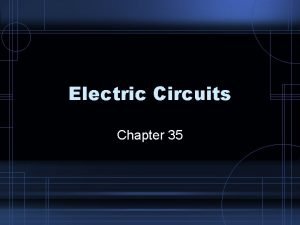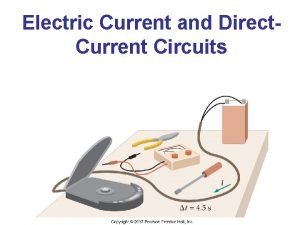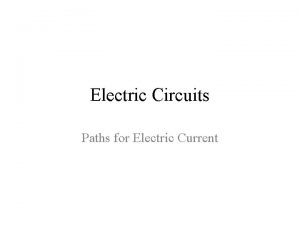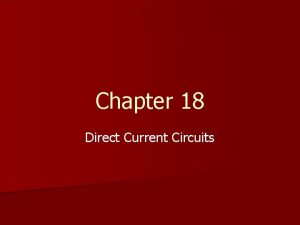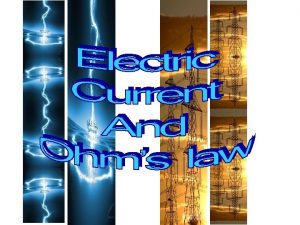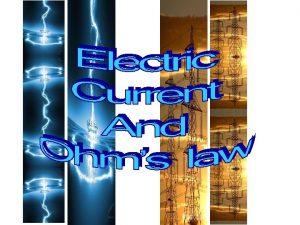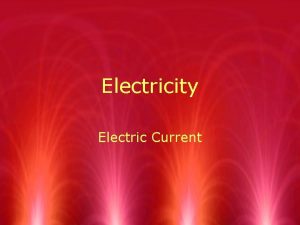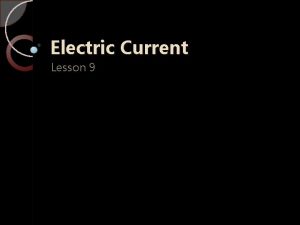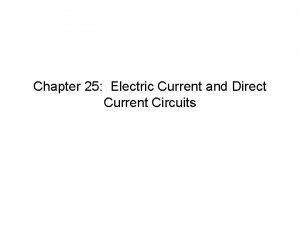Chapter 21 Electric Current and Direct Current Circuits










![Current (in amps [A]) Charge (in Coulombs[C]) Time (in Seconds[s]) Copyright © 2010 Pearson Current (in amps [A]) Charge (in Coulombs[C]) Time (in Seconds[s]) Copyright © 2010 Pearson](https://slidetodoc.com/presentation_image_h2/8b64cd4a75a2a32552ec6a5737a9a9ed/image-11.jpg)
- Slides: 11

Chapter 21 Electric Current and Direct. Current Circuits Copyright © 2010 Pearson Education, Inc.

21 -1 Electric Current Electric current—the flow of electric charge from one place to another. Current (in amps [A]) Charge (in Coulombs[C]) Time (in Seconds[s]) Electric Circuit—A closed path through which charge can flow, returning to its starting point Copyright © 2010 Pearson Education, Inc.

21 -1 Electric Current • Charges do not flow unless there is a potential difference. • Voltage Source—Something that provides a potential difference – Batteries – Generators • It causes current to flow through the flashlight bulb similar to the way the person lifting the water causes the water to flow through the paddle wheel. Copyright © 2010 Pearson Education, Inc.

21 -1 Electric Current flows from the positive terminal to the negative terminal Electrons flow from the negative terminal to the positive terminal Copyright © 2010 Pearson Education, Inc.

21 -2 Resistance and Ohm’s Law • Under normal circumstances, wires present some resistance to the motion of electrons. • Ohm’s law relates the voltage to the current: Copyright © 2010 Pearson Education, Inc.

21 -2 Resistance and Ohm’s Law Electrical resistance in a wire depends on three things: • Thickness of the wire • Conductivity of the wire • Length of the wire Copyright © 2010 Pearson Education, Inc.

21 -2 Resistance and Ohm’s Law Solving for the resistance, we find The units of resistance, volts per ampere, are called ohms: Copyright © 2010 Pearson Education, Inc.

21 -3 Energy and Power in Electric Circuits When a charge moves across a potential difference, its potential energy changes, causing a change in the current: Copyright © 2010 Pearson Education, Inc.

Voltage and Frequency in the US The typical voltage used in the US is 120 V The typical frequency in the US is 60 Hertz Copyright © 2010 Pearson Education, Inc.

Why can a bird perch on bare voltage wires without getting hurt? As long as the bird perches on only one wire, it is safe because there is no potential difference across its feet As soon as the bird touches two bare wires at once, there is a potential difference and the bird will be hurt. Copyright © 2010 Pearson Education, Inc.
![Current in amps A Charge in CoulombsC Time in Secondss Copyright 2010 Pearson Current (in amps [A]) Charge (in Coulombs[C]) Time (in Seconds[s]) Copyright © 2010 Pearson](https://slidetodoc.com/presentation_image_h2/8b64cd4a75a2a32552ec6a5737a9a9ed/image-11.jpg)
Current (in amps [A]) Charge (in Coulombs[C]) Time (in Seconds[s]) Copyright © 2010 Pearson Education, Inc.
 Fundamentals of electric circuits chapter 4 solutions
Fundamentals of electric circuits chapter 4 solutions Electric current
Electric current Conceptual physics chapter 35 electric circuits
Conceptual physics chapter 35 electric circuits Chapter 20 electric circuits
Chapter 20 electric circuits Fundamentals of electric circuits chapter 9 solutions
Fundamentals of electric circuits chapter 9 solutions Fundamentals of electric circuits chapter 7 solutions
Fundamentals of electric circuits chapter 7 solutions Chapter 35 electric circuits answers
Chapter 35 electric circuits answers Circuits ohm's law worksheet answers
Circuits ohm's law worksheet answers Chapter 35 electric circuits
Chapter 35 electric circuits Advantages of parallel circuits over series circuits
Advantages of parallel circuits over series circuits Chapter 21 electric charge and electric field
Chapter 21 electric charge and electric field Chapter 21 electric charge and electric field
Chapter 21 electric charge and electric field








